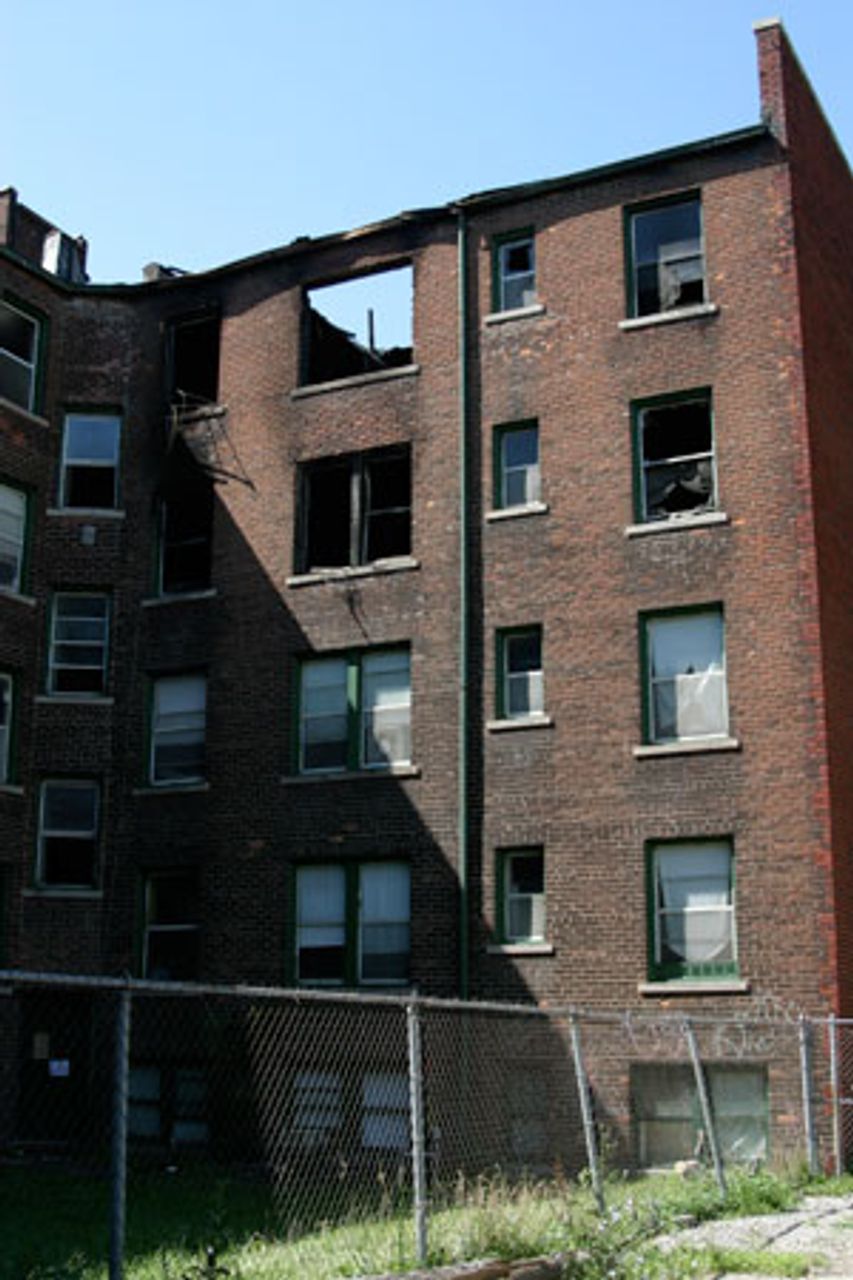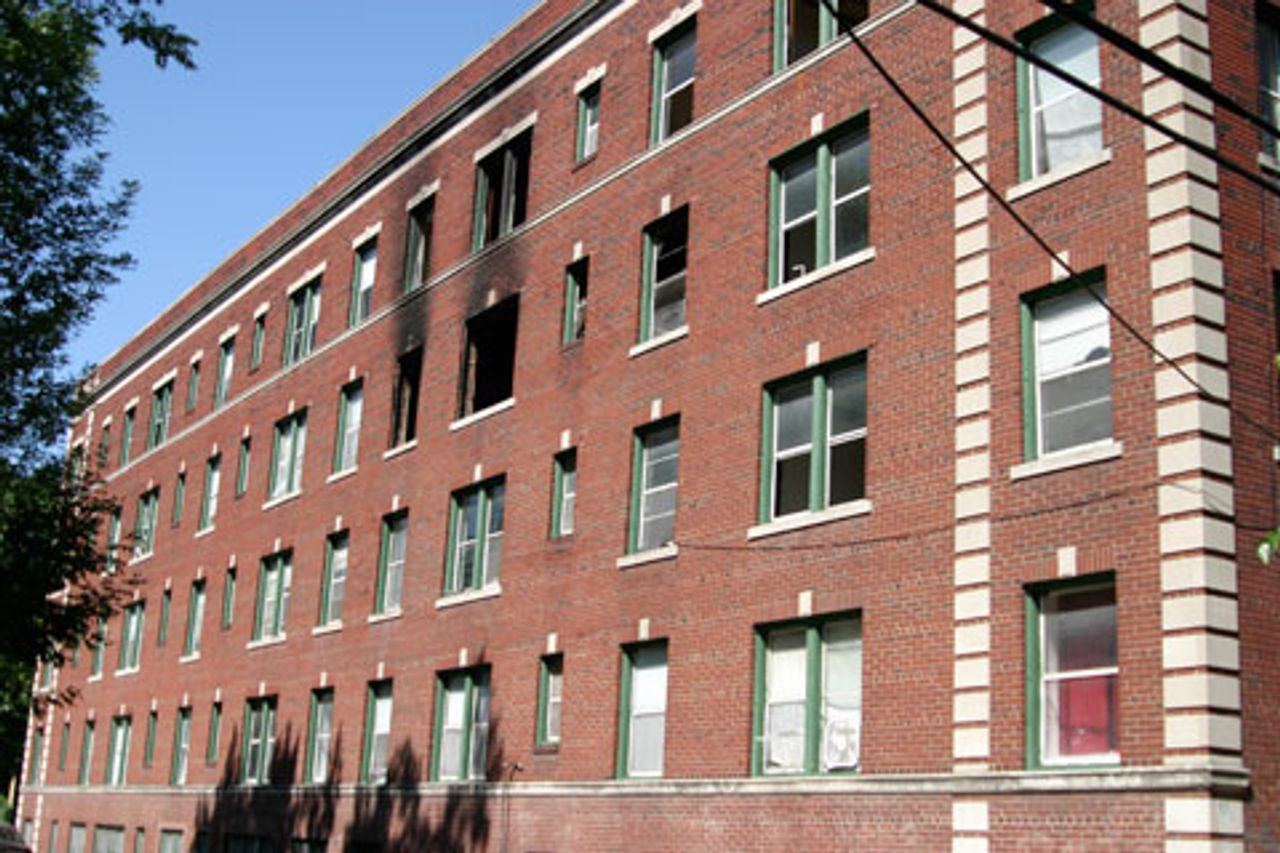 The August 8 fire destroyed a good part of the third
The August 8 fire destroyed a good part of the third and fourth floor. The sky is visible through the
fourth floor after a roof cave-in
The quick thinking and heroic actions of neighbors saved the lives of a Southwest Detroit mother and her four children who jumped from their burning home on August 8.
The identity of the family has not yet been released. When the fire erupted at 3 a.m., all of the residents of Broderick Manor, at 1516 Vinewood, had been able to evacuate except for the family. They were trapped four floors up. Witnesses said they were hanging out of their window, crying out for help, with smoke billowing out around them.
“Save them, save the kids,” was his only thought, said Stephen Fuson, 18. He told the Detroit Free Press, “My friend had a good idea, and we just grabbed it [a white and pink flowered quilt] out of someone’s apartment. We couldn’t see from all the smoke and stuff. It was terrifying to see them.” Fuson, Matt Borieo, 26, and three other men made the rescue by holding out the quilt for first the children and then their mother.
 Alisha Novinsky in front of Broderick
Alisha Novinsky in front of Broderick Manor Apartment Building
Alisha Novinsky, a resident, told the WSWS, “We all were beating on doors trying to get everybody up and out. The only people we couldn’t get to were a family trapped by the fire. Since the fire department took so long to get here, residents had to hold a blanket for the family to jump. The mom landed on a cinder block and broke her spine. The four kids were also injured.
“It got worse,” Alisha said. “EMS didn’t come with the fire department at all. We had to call in and they only brought one ambulance for all five people.”
The mother suffered a broken spine in the fall and was unconscious at the scene, although is reportedly in stable condition. The father waited on a ledge and was rescued by the fire department.
This was the second fire in the building in the last two months, and the fourth since 2006. Only 18 of the 52 apartment units were occupied. According to resident Rochelle Lapsley, the damage from the fire earlier in the year had not yet been fully repaired. All of the residents have been displaced by order of the fire department.
“The slow response time of the fire department and EMS services are normal in the area,” Alisha commented. “The police also are derelict of duty when called.” She said the owner is notorious for not fixing anything. “I once tried to plug an extension cord into an outlet, and I started sparking flames. When I first moved in, my sink was broken, as was my plumbing. After the storm a month ago, the power was out for two days. From all the leaks, the bathroom ceiling caved in, and the kitchen ceiling was cracking as well.”
 Damage from the June 2011 fire on the third floor. Many windows in the building are missing or broken
Damage from the June 2011 fire on the third floor. Many windows in the building are missing or broken“I’m a diabetic with health problems,” she explained. “I can’t live with these conditions. I complained to the landlord and he said the apartment is fine. It isn’t. It’s a danger. I plugged in an extension cord and flames came out of the wall.
“I called the American Red Cross for a place to stay but they said they couldn’t help me. They said they could only help the people whose apartment caught on fire. Right now I’m homeless.”
The spate of apartment fires in the area have their fundamental source in a historic decline of the city as the world’s manufacturing powerhouse, bound up with the collapse of the US as an industrial leader.
The housing of Southwest Detroit mostly dates to the early 20th century when the area was booming with industry. Everything from corsets made by the Schilling Corset Company to meatpacking firms along the Michigan Central Railroad were present. The area was noted for its two dozen brickyards, railway car factories and soda ash production, a derivative of salt used in the plate glass windows of cars.
This made the area a prime location for the growth of the auto and steel industries in Metro Detroit. The district became one of the most densely populated and heavily industrialized parts of the city. The number of factories in Southwest Detroit—interspersed with residential neighborhoods—was world-renowned, attracting a huge and diverse number of immigrants from Ireland, Romania, Appalachia, Hungary, Armenia, Poland and more recently Hispanic and Arab workers.
All the major factories closed down in the past several decades, devastating the area. This includes GM Ternstedt Fisher Body (1988), Guardian Glass (1981), Anaconda Copper and GM Fleetwood Assembly (1987).
The decline of Southwest Detroit is a mirror of the collapse of American industry. And today what remains is not only the worn-out homes and apartments, like the one at 1516 Vinewood, but also the refuse of the former industrial age.
Southwest Detroit is the most polluted area of Michigan, and one of the most polluted in the nation, further endangering residents whose living conditions are already difficult.
The abandoned factories, pipelines, steel smelters and trucking companies have left behind a poisonous mix of manganese, diisocyanates, sulfuric acid, nickel, trimethylbenzene, chromium, lead, hydrochloric acid, glycol ethers, chlorine and cobalt.
A toxicity study by the University of Michigan showed Southwest Detroit with a toxicity score of 2576 as compared to the state median of 18. These chemicals contribute to stunted growth, cardiovascular and cancer risk as well as respiratory and neurological conditions. Rates of asthma hospitalizations in Detroit are three times higher than those in the state as a whole.
